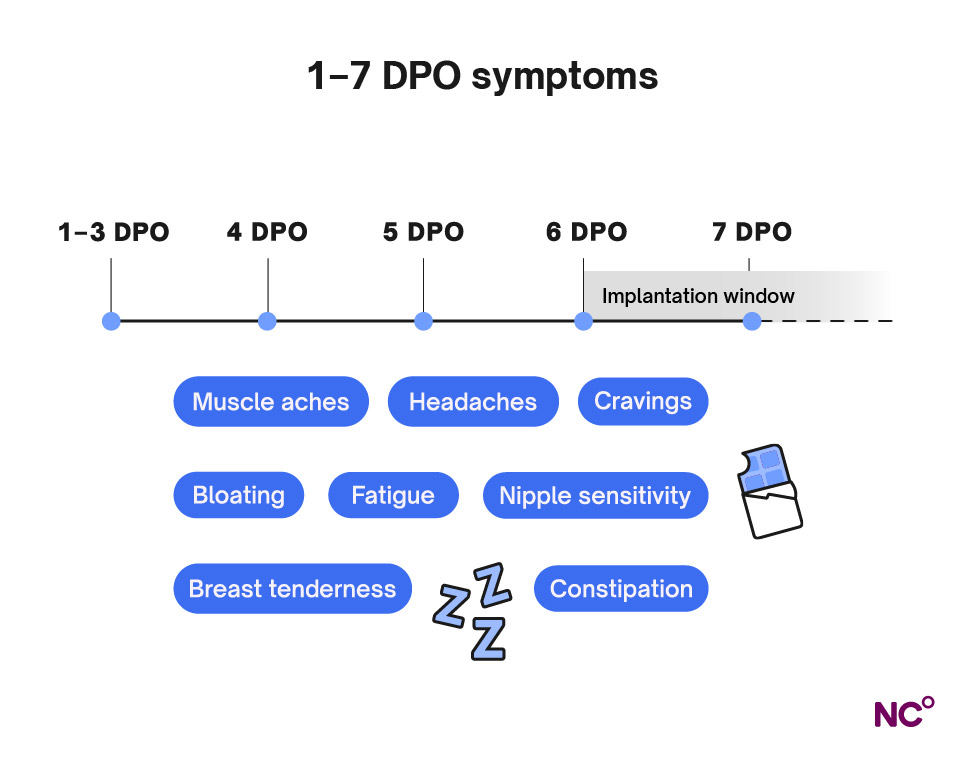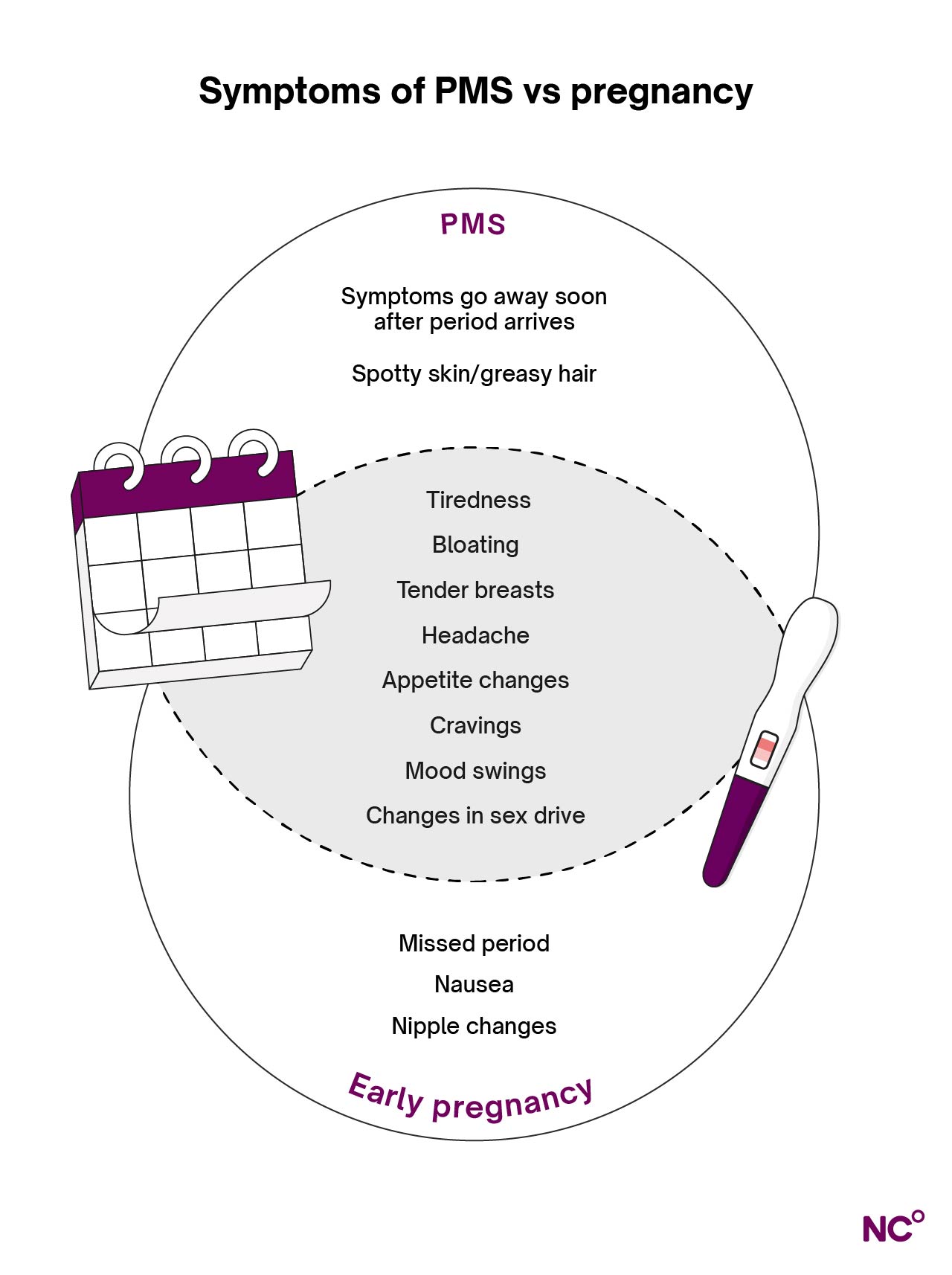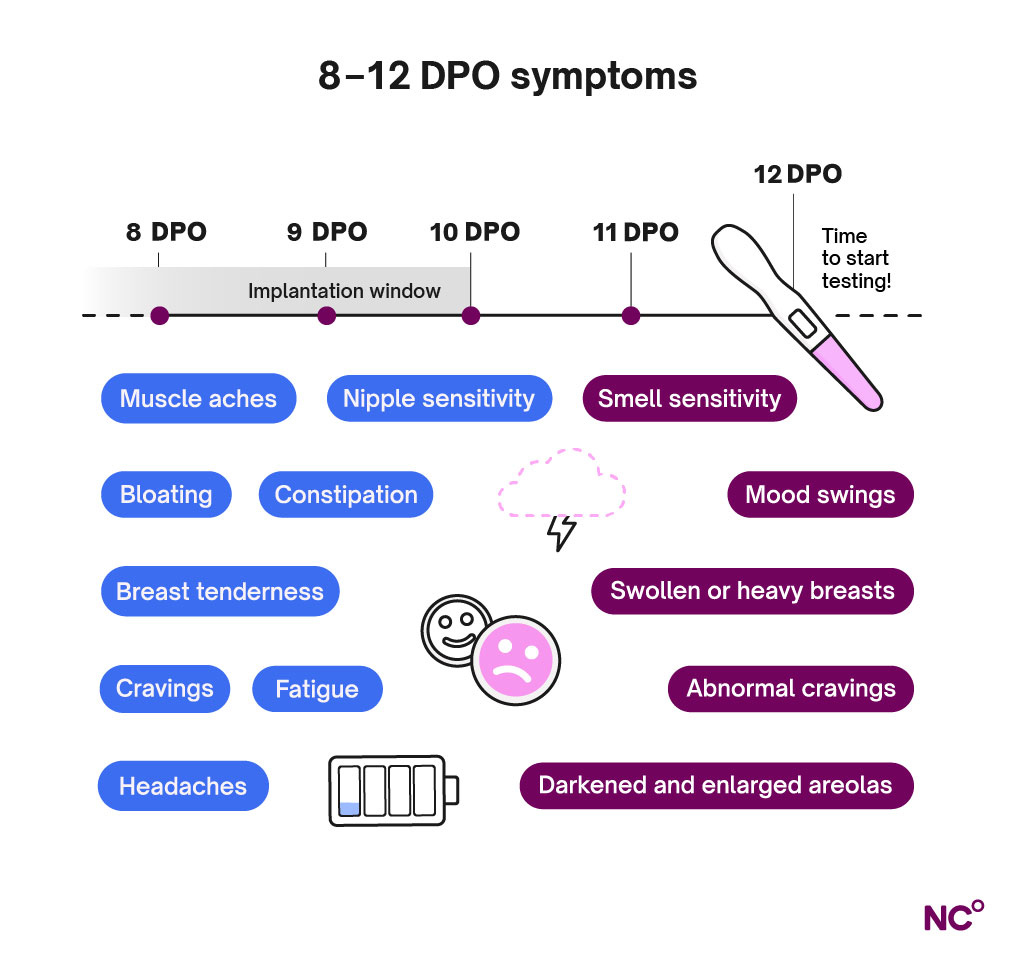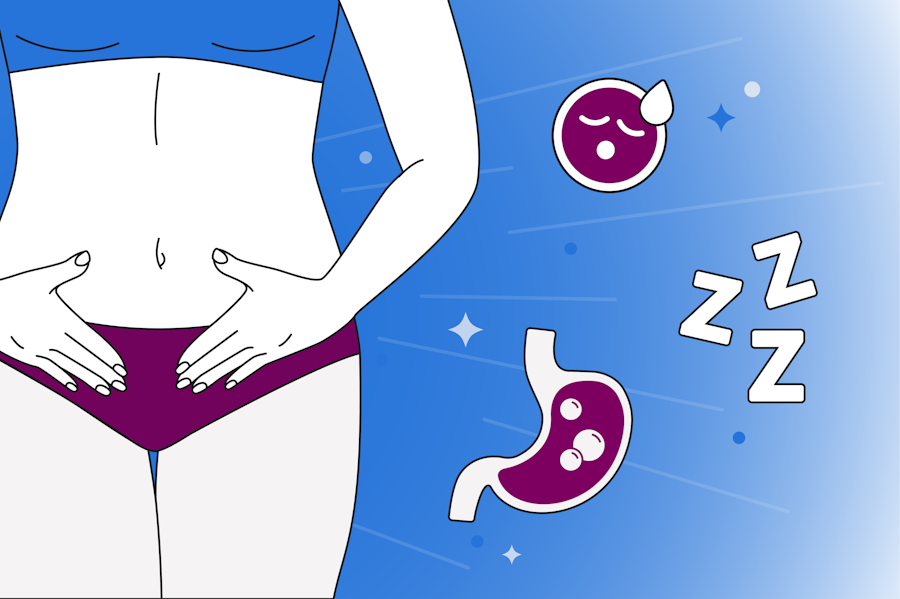1-12 DPO symptoms: What to expect and when to test
Follows NC° Editorial Policy
At Natural Cycles, our mission is to empower you with the knowledge you need to take charge of your health. At Cycle Matters, we create fact-checked, expert-written content that tackles these topics in a compassionate and accessible way. Read more...
Key Takeaways:
- “DPO” is an acronym used by the medical and trying to conceive (TTC) communities that stands for “days past ovulation” or “days post ovulation”
- DPO is the time span between ovulation and your missed period, when some early pregnancy symptoms may start to emerge
- It can be difficult to distinguish these early pregnancy symptoms from PMS symptoms, but there are a few notable differences that may help you navigate your fertility journey with more clarity
Whether you’re trying to become pregnant or just exploring the possibility, you’ve probably come across the term “DPO” in conversations with doctors or online communities. It stands for “days past ovulation,” that nerve-wracking time when you’re wondering if you’re pregnant or not [1]. The 12 DPO, or 12 days past ovulation, can come with a rollercoaster of emotions — from excitement to confusion and maybe even a little frustration — as you’re trying to figure out if your body is dropping hints that you’re pregnant.
In this article, we’ll dive into everything that might be happening in your body during this time, from hormone patterns to physical symptoms, and what those signals might mean for you. It’s important to remember that the only definitive way to tell if you’re pregnant is with a pregnancy test, which usually isn’t accurate until around 14 DPO (ideally, on the first day of a missed period). However, things may start to get interesting during the 12 DPO if conception has occurred.
Quick spoiler alert: everyone’s experience is unique. This article is meant to provide generalized guidance for what to expect during 12 DPO, and should not be a substitute for personal advice from a doctor.
What is days past ovulation (DPO)?
First things first: DPO is an acronym referring to “days past ovulation.” It can also be read as “days post ovulation” or “day past ovulation.” While we’re at it, here are a few more acronyms you might come across as you’re doing research and interacting with TTC communities during your fertility journey:
- BBT: basal body temperature (the body’s lowest resting temperature. Its patterns are used to detect ovulation) [1]
- DPO: days past/post ovulation [1]
- EPT: early pregnancy test [1]
- hCG: human chorionic gonadotropin (the pregnancy hormone) [1]
- IVF: in-vitro fertilization [1]
- IUI: intrauterine insemination [1]
- POAS: pee on a stick (the most common type of at-home pregnancy test) [1]
- TTC: trying to conceive [1]
- TWW: two week wait
The 12 DPO are a popular topic of conversation because these are the days when signs of an early pregnancy may start to emerge. In a confusing coincidence, many of these early pregnancy symptoms are very similar, if not identical, to common symptoms associated with the luteal phase of the menstrual cycle that comes each month after ovulation (whether you’re pregnant or not) [2]. This means that the DPO can be a nail-biting period of uncertainty, waiting, hope, or disappointment.
1 to 12 DPO pregnancy symptoms to expect
We know this time can be overwhelming in many ways, so we’re here to break down exactly what happens during the 12 DPO to help you feel more confident in your fertility journey. Again, while some people will experience some or all of these symptoms, others may experience none of them and still be pregnant. On the other hand, you may experience some of these things and not be pregnant, since they’re quite similar to luteal phase symptoms [2].
With that in mind, symptoms alone are not a definitive marker of whether or not you’ve conceived a baby — only a pregnancy test can provide that answer — and we encourage you to try not to rush to conclusions. However, if you’re curious about what might be happening in your body during the DPO, there are some common biological processes and patterns we can explore.
1 to 3 DPO symptoms: progesterone rises
In the first 48 hours after conception, the symptoms post-ovulation will most likely be linked to the luteal phase of your menstrual cycle, as these symptoms are associated with a rise in the progesterone hormone. It’s just too early in the process for you to experience any distinct pregnancy symptoms just yet. Symptoms of rising progesterone include:
- Bloating
- Breast tenderness/nipple sensitivity
- Cravings
- Fatigue
- Headaches
- Muscle aches [2]
These symptoms can happen every cycle after ovulation, regardless of whether or not pregnancy occurs. Let’s remember that in order for pregnancy to happen, sperm needs to fertilize the egg cell released during ovulation. This usually happens in the fallopian tubes. Then, the fertilized egg cell (also called a zygote) needs to travel through the rest of the tube to the uterus and attach to the uterine lining (a process called implantation). It’s only once all of that has happened that conception has occurred and early pregnancy has begun [3].
All of this happens over the course of the 12 DPO, so during 1-3 DPO, it’s likely you’re at the beginning of that process when sperm is trying to fertilize (or has already fertilized) the egg released during ovulation in your fallopian tubes. Progesterone is rising as it is still being produced by your ovaries, the same way it is produced every cycle (regardless of whether or not an egg cell is fertilized). And it’s this rise in progesterone levels that can cause some of the symptoms listed above [3].
4 DPO symptoms: making moves
If sperm fertilize the egg cell during those initial days DPO, at 4 DPO, the fertilized egg is now moving through your fallopian tubes toward your uterus. Symptoms would be similar to those listed above, whether you’re pregnant or not, as this day is still characterized by the gradual rise of progesterone levels, which are also associated with the luteal phase [2].
5 DPO symptoms: blastocyst development
The fertilized egg is on the move in your fallopian tubes during 5 DPO — it takes time to make its way through your body! By the time of 5 DPO, the zygote is approaching your uterus and has expanded and divided into multiple cells until it becomes a blastocyst (a cluster of 100-200 cells) [3]. Again, symptoms will be similar to those listed above, associated with the luteal phase, not early pregnancy.
6 DPO symptoms: the end of the fallopian journey
Around 6 DPO, the blastocyst will likely be quite close to the uterus, getting itself ready for implantation into the uterine lining. You probably won’t be experiencing any symptoms outside of those listed above, but don’t worry — things may get more exciting around day 7 [2, 3].
7 DPO symptoms: possible implantation
At 7 DPO, the blastocyst has likely made its way to the uterus and attempts to implant into the uterine lining. This is vital for its further growth and development into an embryo, as implantation is how the blastocyst will receive nutrients and energy from the mother. The uterine lining is only receptive to incoming blastocysts for a few days each cycle, usually around 6-10 DPO. This is sometimes referred to as the WOI, or “window of implantation,” meaning that implantation can happen any time from 6 DPO to 10 DPO, and may actually happen over the course of a few days. [3].
If implantation is successful, this marks the beginning of a pregnancy. At the time of implantation, the embryo starts to produce the pregnancy hormone hCG to support the pregnancy in your uterus. Levels of this hormone are still quite low on this day, though, so you probably won’t be experiencing symptoms related to it just yet [4].
Any symptoms you have are likely still related to rising progesterone levels, which naturally peak around 6 to 8 DPO whether you’re pregnant or not. These symptoms can feel like stronger versions of what you may have noticed earlier in your cycle at 1-3 DPO [2].
If implantation happens, your body will sustain this peaking progesterone level. During a regular menstrual cycle, progesterone will drop over the next couple of days to bring on the beginning of your period [5].

8 DPO symptoms: implantation (cont.)
Depending on individual variation in embryo development and transport through the fallopian tube, implantation may happen anywhere from 6-10 DPO [3]. Some people may still experience luteal phase symptoms during this time [2]. Remember: it’s totally normal not to experience any symptoms at this point, and any symptoms you do experience are likely linked to the luteal phase and not early pregnancy..
The tough part of this is that it’s still too early to take a pregnancy test and get an accurate result, and the intensity associated with these symptoms may also be part of your regularly occurring luteal phase. This is why 1-12 DPO is also often referred to as the “two week wait” (TWW).
1-12 DPO and TWW get used somewhat interchangeably because two weeks (about 14 days) post-ovulation is usually when a pregnancy test will show accurate results, so it’s best to “wait” until then to test if you can. There’s no harm in testing earlier, but it’s much more likely that you’ll get a false negative [6, 7].
9 DPO symptoms: light bleeding
At 9 DPO, and typically anywhere from 7-14 DPO, about some individuals experience light bleeding or spotting. This is a common symptom of successful implantation and is sometimes referred to as implantation bleeding. The blood is a result of the blastocyst moving into the uterine lining, which causes a small part of that lining to shed [8].
However, this is not a certain sign of pregnancy. Bleeding around this time can also just be a sign of progesterone dropping around this time in your menstrual cycle. Less likely, it might mean that a very early miscarriage has occurred (also sometimes called a chemical pregnancy), or it may be a symptom of a different underlying health condition [8]. Talk to your doctor about your symptoms if you experience abnormal bleeding.
10 DPO symptoms: hormones surge
At around 10 DPO, levels of the hCG pregnancy hormone should be surging in your body if you’re pregnant. While individual hCG levels varied widely, one study found that urinary hCG concentrations increased significantly in the first week after detection, with the most rapid rise (threefold) occurring on the first day [4].
The progesterone hormone is also at peak levels in your body right now. Progesterone plays a few key roles in supporting early pregnancy:
- It helps mature the lining of the uterus (endometrium), preparing it for implantation.
- It stimulates the uterine lining to supply nutrients to the new pregnancy.
- It thickens and decreases the elasticity of cervical mucus to create a mucus plug that will protect the uterus from infection during pregnancy. [5]
So if implantation is successful, progesterone levels will remain high to fulfill those functions and sustain the pregnancy. However, if the egg is not fertilized during ovulation, or if implantation doesn’t happen, progesterone levels will drop as your luteal phase goes on, potentially leading to PMS symptoms and eventually signaling the start of a period. [5, 9]
Learn more about progesterone’s effect on your body throughout your life here.
11 DPO symptoms: early pregnancy signs
Focusing back on the hCG pregnancy hormone, levels will start rising at around 10-11 DPO if you’ve conceived, so you may start experiencing early pregnancy symptoms associated with this hormone (although many people will still not have any pregnancy symptoms at this point). Symptoms include:
- Abnormal cravings or more hunger than usual
- Cramping
- Darkened color and enlargement of the areolas
- Digestive issues like nausea or diarrhea
- Fatigue
- Increased frequency of urination
- Smell sensitivity and altered taste
- Swollen or heavy breasts [10]
To make things confusing, these early pregnancy symptoms can happen in addition to the symptoms associated with the luteal phase, symptoms mentioned earlier. Pregnancy can be quite tough on your body! The good news is that these symptoms might be unique enough to help you figure out if your body is giving you signals that you’re pregnant, rather than just going through the luteal phase. Tracking your symptoms with Natural Cycles, each cycle may help you identify your common symptoms to see if anything is out of the ordinary.

Again, we want to share a quick reminder that the only surefire way to confirm a pregnancy is a positive pregnancy test, which brings us to…
12 DPO symptoms: is it time to test yet?
If you are experiencing the symptoms listed above, and they’re not typical for you in a regular menstrual cycle, it’s possible that your hCG levels are now high enough at 12 DPO to be detectable on a pregnancy test. A blood test at a doctor’s office will detect hCG levels sooner than an at-home test, but it’s possible that an at-home test could come back positive as well at this point [11].

Let’s learn more about timing, false results, and how pregnancy tests work in general:
Can you take a pregnancy test at 12 DPO?
The short answer is yes, although you may receive a false result if you do an at-home urinary test. The long answer is that all urine pregnancy tests work the same way — by detecting the presence of hCG in your body (though the sensitivity of the test can differ).
Let’s do a quick refresher on what needs to happen during ovulation for a pregnancy to occur:
- Ovulation: A mature female egg cell must be released from an ovary into the fallopian tubes around the midpoint of your cycle (ovulation).
- Sperm: Sperm cells must enter the uterus and make their way to the fallopian tubes.
- Fertilization: The egg lives for no longer than 24 hours, and must meet with a sperm cell in the fallopian tubes to become fertilized
- Implantation: The fertilized egg cell must also travel through the rest of the fallopian tube (where it grows into a blastocyst) to the uterus and implant in the uterine lining (implantation). This can take a few days, but if it happens, your body starts to produce hCG to support the new pregnancy [3, 6].
Learn more about the process of fertilization and conception here. The hCG hormone is only created when all of this goes off without a hitch. If it does, it will start to be produced at around 6-8 DPO by the developing embryo. However, it can still take a few days for hCG levels to rise to detectable amounts (again, we know that the waiting game can be a huge challenge) [6].
Luckily, a blood test can detect hCG as early as 7-12 DPO. An at-home urine test will detect hCG closer to 12-15 DPO. So, although the 12 DPO may be enough time to provide an accurate test result from a blood test with a doctor, it may still be a bit early for an at-home test. For the most accurate result, the general guidance is to wait until 14 DPO, or the first few days of your missed period, to take a pregnancy test [11]. Keep in mind that if you have a late period but got a negative pregnancy test result at or around 12 DPO, you should test again in a few days.
If you’re using Natural Cycles, our technology can help you figure out if your period is late because you had late ovulation or if you might be pregnant. Either way, going forward, you can use Natural Cycles to track your unique fertility cycle and learn more about when and how to take pregnancy tests.
|
Enjoying what you’re reading? Follow us on Instagram for more myth-busting female health content. |
Symptoms after ovulation if pregnant or not
To sum it up and help demystify this 12 DPO period, here are some slight distinctions in the symptoms you may be experiencing that can help determine if your symptoms are signaling pregnancy or not:
|
Symptom |
Indications of PMS |
Indications of pregnancy |
|
Bleeding |
Begins around 14 DPO and signals the start of menstruation [9] |
May happen earlier, between 7 and 14 DPO, and will typically be lighter in flow [10] |
|
Breast changes |
Tender or sore, slightly swollen [9] |
Darkening and enlargement of the areolas [10] |
|
Cravings |
Your go-to PMS foods like chocolate, carbs, cheese, etc. [9] |
Very specific and/or abnormal cravings. You may notice changes in your sense of smell, too [10] |
|
Cramps |
Dull, achy, more severe cramps may be accompanied with nausea, diarrhea and other symptoms [12] |
Typically, cramps have a milder sensation [13] |
Can DPO symptoms be mistaken for PMS?
All of this means that yes, DPO symptoms can be mistaken for PMS symptoms, but there are slight differences that may be able to help you determine what you’re experiencing. Keep in mind that everyone’s body and symptoms are unique.
Early pregnancy signs
Beyond the 12 DPO, hCG will continue to rise in your body through the first few weeks of pregnancy. During that time, it’s possible to experience early pregnancy signs including:
- Missed period or light spotting
- Nausea with or without vomiting
- Breast changes and/or soreness
- Frequent urination
- Strange cravings, tastes, and smells [10]
- Elevated basal body temperature (BBT)
These are the most common telltale signs of early pregnancy, but remember that each person (and each pregnancy) has its own unique factors that will contribute to how you experience the first trimester. Learn more about your pregnancy journey with the Follow Pregnancy resources and tools from Natural Cycles, including useful information like when you start showing in pregnancy, tips for exercise during pregnancy, guides for sex during pregnancy, and much more.
When to see a doctor
If you think you might be pregnant or you’re TTC, it’s always a good idea to check in with your doctor. They can provide the personalized care and advice you need to boost your chances of pregnancy, and confirm it earlier than at-home tests. If waiting the full 12-14 DPO sounds like forever to you, talk to your doctor about getting a blood test to find out sooner [11].
Consult your doctor about any abnormal symptoms you’re experiencing as well, especially if they’re causing you any pain or distress. They’ll provide specialized testing and treatment to make sure you’re on the right track to a healthy pregnancy.
Plan for pregnancy with Natural Cycles
Did you know that your body temperature can help determine your fertile days, making it easier to conceive at the right time? The road to becoming pregnant can sometimes feel bumpy, but Natural Cycles can support you with the knowledge and tools to optimize your fertility journey. Want to get pregnant faster? Research has shown that Couples using NC° to plan a pregnancy take 3 cycles on average to get pregnant [14]. Sign up to find out more.
Did you enjoy reading this article?
